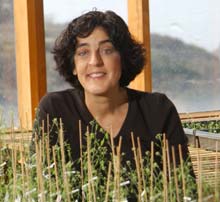Salk Scientists Identify Pathway That Determines When Plants Flower

Joanne Chory
Salk scientists have defined a new pathway that controls how plants flower in response to shaded, crowded conditions, and their findings may have implications for increasing yield in crops ranging from rice to wheat.
The study, published in the June 19 issue of Nature, was led by Salk professor and Howard Hughes Medical Institute Investigator Joanne Chory and Salk/Howard Hughes Medical Institute postdoctoral fellow Pablo Cerdán. “The mechanism that leads to plants flowering early in response to shaded conditions has largely been unknown,” said Chory. “And this is a major problem for crops, which are planted at high density and often shade each other in the field. By understanding this process, we may someday be able to control plant flowering responses to shade and, in turn, increase the yield of crops.”
The Salk researchers focused on what is known in plants as the “shade-avoidance syndrome.” When plants grow in high density, they perceive a decrease in the relative amounts of incoming red light to light of other wavelengths. This change of light serves as a warning for competition, prodding the plants to flower and create seeds. The byproduct of this process is that plant stems grow longer and leaf volume declines, leading to decreases in biomass and yield.
To understand the biology behind this process, the Salk scientists looked at a group of phytochromes, photoreceptors in plants that trigger the “shade-avoidance response.” Using the common mustard seed plant Arabidopsis-the first plant to have its entire genome sequenced by a multinational consortium that involved Salk professor Joe Ecker and other researchers-Chory and Cerdán identified the specific protein that triggers flowering in response to suboptimal light conditions.
“We screened for mutant versions of Arabidopsis to identify the protein and the signaling pathway that leads to flowering in shade conditions,” said Cerdán. “We discovered that the protein, called PFT1, acts downstream from a specific phytochrome, phyB, to begin this process.”
Phytochromes have been studied by plant biologists for 50 years, and yet the complex pathways that lead to flowering are still not fully understood. “Even though the pathways that induce flowering are some of the best studied in plants, there still are a lot of new players to be identified,” said Chory.
The researchers are encouraged by the implications of their initial findings. “In agriculture, it’s all about yield,” said Chory. “Flowering time pathways in Arabidopsis have a great degree of similarity to rice, and we hope that this research will ultimately have applications for improving the yield of rice and other crops.
“There are more than 800 million people in the world who are chronically malnourished, and discovering new methods to increase crop yield is crucial to addressing world hunger,” she said.
The study was funded by a grant from the National Institutes of Health and the Howard Hughes Medical Institute.
The Salk Institute for Biological Studies, located in La Jolla, Calif., is an independent nonprofit dedicated to fundamental discoveries in the life sciences, the improvement of human health and conditions, and the training of future generations of researchers. The institute was founded in 1960 by Jonas Salk, M.D., with a gift of land from the City of San Diego and the financial support of the March of Dimes Birth Defects Foundation.
Media Contact
More Information:
http://www.salk.edu/news/releases/details.php?id=71All latest news from the category: Life Sciences and Chemistry
Articles and reports from the Life Sciences and chemistry area deal with applied and basic research into modern biology, chemistry and human medicine.
Valuable information can be found on a range of life sciences fields including bacteriology, biochemistry, bionics, bioinformatics, biophysics, biotechnology, genetics, geobotany, human biology, marine biology, microbiology, molecular biology, cellular biology, zoology, bioinorganic chemistry, microchemistry and environmental chemistry.
Newest articles

You are What You Eat—Stanford Study Links Fiber to Anti-Cancer Gene Modulation
The Fiber Gap: A Growing Concern in American Diets Fiber is well known to be an important part of a healthy diet, yet less than 10% of Americans eat the minimum recommended…

Trust Your Gut—RNA-Protein Discovery for Better Immunity
HIRI researchers uncover control mechanisms of polysaccharide utilization in Bacteroides thetaiotaomicron. Researchers at the Helmholtz Institute for RNA-based Infection Research (HIRI) and the Julius-Maximilians-Universität (JMU) in Würzburg have identified a…

ASXL1 Mutation: The Hidden Trigger Behind Blood Cancers and Inflammation
Scientists show how a mutated gene harms red and white blood cells. LA JOLLA, CA—Scientists at La Jolla Institute for Immunology (LJI) have discovered how a mutated gene kicks off…



